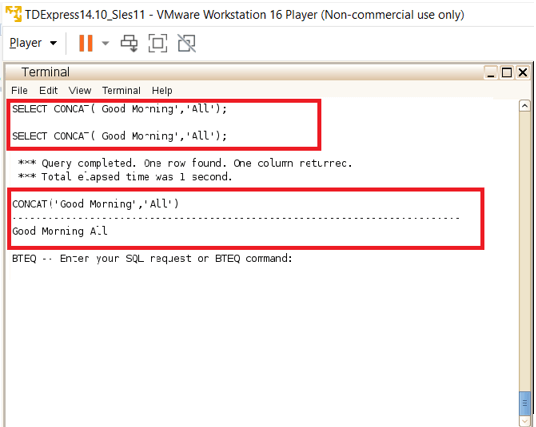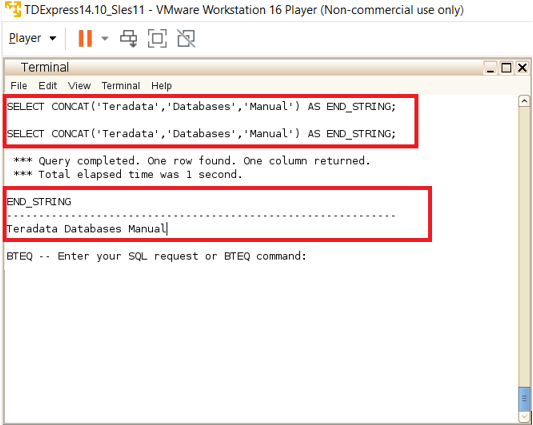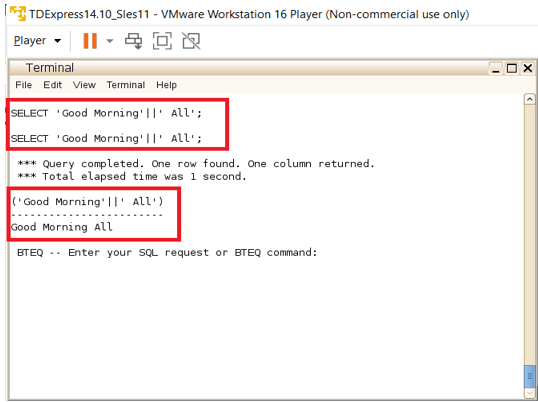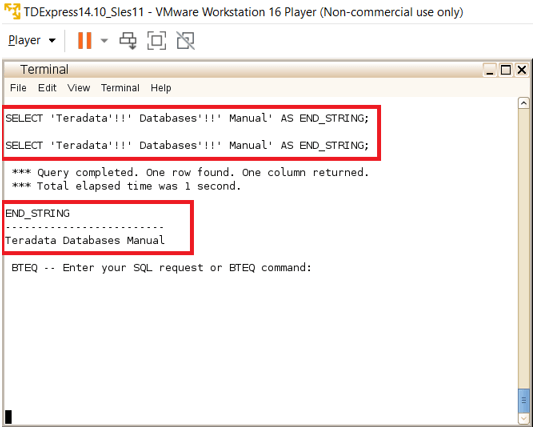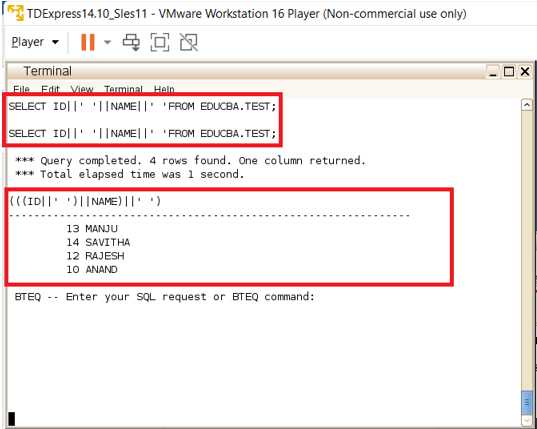Updated March 6, 2023

Introduction to Teradata Concatenate
In every data-based software item, concatenation is a very predominant part. Concatenate is the process of combining values. When one string and another string are expected to be joined together then concatenation comes into play. So basically, concatenation is a process of compounding two strings or column values of two strings together. For Teradata case, the process of concatenation can be achieved in two ways. One the concatenation process can be performed through concatenation operator whereas the other way involves the process using the CONCAT() function to perform the concatenation process. Here the concatenation function can be used for the concatenation of both string and numeric values.
Concatenation using CONCAT() Function:
Syntax:
CONCAT (expression_value_column_1, expression_value_column2 [, expression_value_column_n] [...])Syntax Element Description
expression_value_column The string or column value on which the concatenations are expected to happen are listed here. How many string or column values are needed to be concatenated are listed here sequentially. All the listed expressions will be concatenated by the Concat() function and the concatenated value will be returned. The concat function allows the concatenation of string, numeric, and byte values.
Teradata CONCAT() Rules, Types, and Compliance:
- The CONCAT is compliant of ANSI SQL:2011 standard.
- All the given strings will be concatenated and more importantly, the CONCAT function by default performs the concatenation from left to right.
- The CONCAT() functions are ODBC supported hence cannot be executed from the usual Teradata terminal.
Examples of Teradata Concatenate
Below are some different examples.
Example #1
Here in the First example concatenation of two strings is performed in the select query using the CONCAT() function. Here two strings ‘Good Morning’ and ‘All’ are concatenated. The concatenated output will be returned by the CONCAT() function as a single string value ‘Good Morning All’. We can notice this single string being generated and placed at the string output in the console.
Query:
SELECT CONCAT('Good Morning','All');Output:
Example #2
Here in the Second example concatenation of three strings is performed in the select query using the CONCAT() function and the concatenated value is tagged under a column name called END_STRING. Here Three strings ‘Teradata’ and ‘Databases’ and ‘Manual’ are concatenated. Just as like the above-depicted example here too the concatenated output will be returned by the CONCAT() function as a single string value mentioning as ‘Teradata Databases Manual’. We can notice this single string being generated and placed at the string output in the console under the column name END_STRING.
Query:
SELECT CONCAT ('Teradata', 'Databases', 'Manual') AS END_STRING;Output:
Concatenation using Pipe || operator:
This is the more standardized method for concatenation in Teradata enterprise systems. As per the Teradata manual, this operator-based concatenation is the more preferred way of concatenation. As with CONCAT() function the concatenation operator is also used for the concatenation of two strings are numeric values. The || symbol is used for concatenation. More than one concatenation inputs can be passed to these operators whereas the output of the concatenation function is always a single value returned. Teradata allows the capability of making the concatenation operation to happen not only by means of pipe || operator but it can also be performed by means of the exclamatory operator !!. Even though an exclamatory operator can be used for this purpose it is not considered as a standardized symbol of concatenation as per Teradata manuals. We can discuss these different operators used for concatenation in Teradata systems in the below-listed examples.
Syntax:
expression_value_column_1 || expression_value_column2 || expression_value_column_n]| Syntax Element | Description |
| expression_value_column | Just As like the expression value in the CONCAT function the expression value in the concatenate operator is also expected to work the same way, the string or column value on which the concatenations are expected to happen are listed here. How many string or column values are needed to be concatenated are listed here sequentially with the || symbol being placed in between each other. Every string value expected to be concatenated needs to be placed with a single quote’s special character. In case column values are expected to be combined then the column names need to be expressed sequentially in the expression_value_column labels. Again, the column values are expected to be separated by a || operator symbol. |
Concatenation operator Functions Examples
Example #1
Here in the First example concatenation of two strings is performed in the select query using the || parallel pipe operators. Here two strings ‘Good Morning’ and ‘All’ are concatenated with the || pipe operator hardcoded in between them. The concatenated output will be returned as a single string value ‘Good Morning All’. We can notice this single string being generated and placed at the string output in the console.
Query:
SELECT 'Good Morning'||' All';Output:
Example #2
Here in the Second example concatenation of two strings is performed in the select query using the !! parallel exclamatory operators. Here three strings ‘Teradata’, ‘databases’ and ‘Manual are concatenated with!! Exclamatory operator hardcoded in between them. The concatenated output will be returned as a single string value ‘Teradata Databases Manual’. We can notice this single string being generated and placed at the string output in the console. Additionally, we can notice this single string being generated and placed at the string output in the console under the column name END_STRING.
Query:
SELECT 'Teradata'!!' Databases'!!' Manual' AS END_STRING;Output:
Example #3
Here Two columns from the EDUCBA.TEST database is concatenated using the || concatenation operator. The Columns ID and NAME are concatenated from this database and are printed onto the console. We can notice from the console output the concatenated columns are being displayed.
Query:
SELECT ID||' '||NAME||' 'FROM EDUCBA.TEST;Output:
Conclusion
As far as Teradata is concerned Teradata allows the concatenation process to be accomplished by multiple techniques. The techniques include the use of CONCAT() function, Use of parallel pipe(||) operator for concatenation, and also use of parallel exclamatory symbols (!!) for concatenation process. Among these techniques, the Parallel pipe(||) symbol is the most standardized method for concatenation processes in Teradata databases.
Recommended Articles
We hope that this EDUCBA information on “Teradata Concatenate” was beneficial to you. You can view EDUCBA’s recommended articles for more information.
